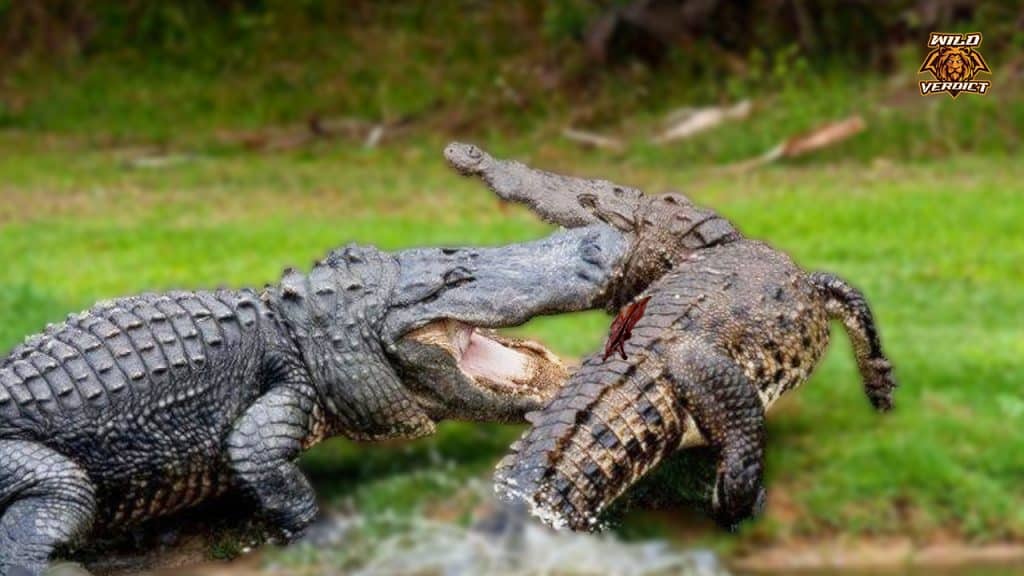
Which would win in a fight to Death?
Alligators and caimans belong to the same family, Alligatoridae, while crocodiles belong to a distinct family.
As a result, alligators and caimans are more similar to one another.
The Alligator is a giant semi-aquatic carnivorous reptile with four legs and a huge tail.
The tail is half the length of the animal and is used to help the alligator navigate through the water, used as a weapon, and stores the fat that they use during winter.
The black caiman is the world’s biggest alligator.
These resilient reptiles were nearly extinct due to overhunting, but conservation efforts over the last few decades have ensured that their population is now safe and prospering.
Size and Body Description
The American Alligator is 11.2 feet (3.4m) long and can grow up to 1,000 pounds in weight or 454 kg; males are slightly larger than females.
They have small, bony scales called scutes that cover the animal’s dark skin. A long, powerful tail and webbed feet aid in the animal’s propulsion through the water.
They are warm-blooded animals and depend on the environment for their warmth. They will do this by basking in the sun or digging holes in the mud to trap heat.
The broad, rounded snout and black color of an alligator distinguish it from all other similar reptiles. All of its top teeth are visible when its mouth is closed.
The black caiman can reach 6 m long and 400 kg in weight. As a result, it is the most prominent Caiman family and the most powerful predator in the Amazon basin.
The appearance of the Black Caiman is similar to that of the American Alligator, but the Black Caimans are dark in color.
Black caiman has gray banding on the lower jaw, with pale yellow or white stripes across the sides of their body; these are more prominent in juveniles. This banding gradually disappears as the animal matures.
A bony ridge distinguishes the Black Caiman and is situated over their reddish eyes. They also have black, scaly skin. The hue of a Black Caiman’s skin helps it blend in with its surroundings during its nighttime hunts and can help with heat absorption.
Range and Environment
The American alligator can be found from North Carolina to Texas, from the Rio Grande to the Gulf of Mexico.
Slow-moving freshwater rivers are home to alligators.
They can be found in swamps, marshes, and lakes. But due to the lack of salt glands, it can withstand salt water for a short time.
Much of the Amazon Basin is home to the black caiman, which may be found throughout northern and central South America and Bolivia, Brazil, Colombia, Ecuador, French Guiana, Peru, and Guyana.
They can be found in shallow freshwater bodies of water such as slow-moving streams, rivers, lakes, and flooded savannah and wetlands.
Diet
Alligators are carnivores and eat nearly everything in their sight.
Fish, turtles, birds, other reptiles, and small mammals appear to be it’s favorites.
They will occasionally catch larger prey and pull it below to drown it before bringing it above water to eat it.
Alligators are characterized as lurkers because they do not hunt for food but instead wait for it to pass them by.
When gators are hiding, they float beneath the water’s surface, only their eyes and nostrils visible.
During the winter, alligators do not feed. As a result, they can endure the winter on their energy stores and even survive cold temperatures if they stay in the water.
Black Caimans devour fish such as piranha and catfish and other species such as birds, turtles, and land-dwelling animals such as capybaras and deer.
Larger caimans can eat tapirs and anacondas.
Because their teeth are intended to grasp rather than rip, they swallow their food entirely after being drowned.
Before moving on to bigger terrestrial prey, juveniles eat crustaceans and insects.
Jaguars are the main predators of adult black caimans in their ecology.
Humans also pose a threat, since they kill them for leather skin or meat.
Behavior
Alligators are social creatures who frequently assemble in groups known as congregations. These groups are typically seen sunbathing or swimming.
Alligators cannot regulate their internal temperature. So, when it’s cold, they sunbathe, and when it’s hot, they go swimming.
They are awkward on land, but their tails allow them to swim very quickly in the water.
This makes catching prey easier for them. Alligators in the United States can swim approximately 20 mph (32.2 km/h) and speed up to 11 mph (17.7 km/h) on the ground.
Floods occur throughout the Amazon from May to July, so Black caiman is scattered across their area. The dry season lasts from September to December, when water levels drop and flooded savannahs dry up, causing them to congregate more heavily in stable rivers and lakes.
They primarily hunt at night, relying on their acute vision and hearing. To communicate with their species, black caimans emit rumbling thunder-like noises.
They, like most crocodilians, take care of their offspring.
Now it’s time to see who will emerge victorious in a fight between these two ferocious reptiles.
It’s a very close fight, with the triumphant animal suffering from severe wounds and possibly losing a limb.
Alligators and caimans fight by biting each other with their mouths.
Their jaws are pretty powerful, and a single bite can cause tremendous harm.
One thing to keep in mind is that caimans are slightly longer than alligators.
They’re also more nimble and have slenderer teeth than alligators, but alligators are speedier and have a more substantial bite!
As a result, alligators, in my perspective, are more likely to cause more damage to black caimans and hence emerge as winners.

